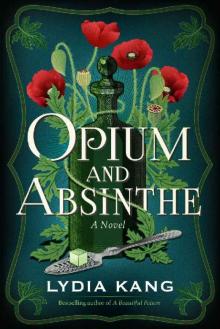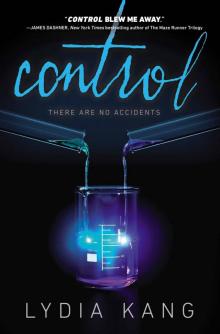- Home
- Lydia Kang
Quackery Page 3
Quackery Read online
Page 3
SaltAncient mariners knew that drinking seawater could cause a good upchuck. The Greeks used a combination of salt, water, and vinegar. Pliny the Elder recommended a nice mixture of honey, rainwater, and seawater called thalassomeli to do the trick. Celsus described using wine and seawater, or salted Greek wine, to “loosen the belly,” which is the gentlest way ever to say vomit. Of course, drinking heavily salted water can make you vomit, but it can also kill you.
Beer and crushed garlic Philumenus, a Greek physician from the fourth century, thought that a combination of beer and crushed garlic could cure poisonous asp bites via vomiting. Given that snakebite poison doesn’t collect in the stomach, seems like you’re adding insult to injury here.
Blue vitriol (copper sulfate) A crystalline substance with a striking blue color, it’s been used as an emetic since the ninth century. In an 1839 magazine, blue vitriol is recommended for opium and hemlock poisonings. Unfortunately, blue vitriol is itself poisonous: It causes red blood cells to pop, muscle tissues to break down, and kidneys to fail.
Ipecac (short for ipecacuanha) First brought to Europe in the 1600s. No, it’s not mentioned in a song called “The Girl from Ipecacuanha. ” Syrup of ipecac was used for centuries as an expectorant and emetic. For years, ipecac was also used for poisoning and was considered a necessary component of every parent’s medicine cabinet in the nineteenth and early twentieth centuries. It’s still available today. But modern toxicologists know it doesn’t reliably decrease the absorption of toxins, and half the time, it doesn’t even make you throw up. And the song is “The Girl from Ipanema,” okay?
Apomorphine This hallucinogenic drug comes from the bulbs and roots of certain water lilies (the Nymphaea genus). Used by the Maya and immortalized on ancient Egyptian tomb frescoes, the drug was eventually synthesized in the mid-1800s. And it was potent. A 1971 review described its success rate as nearly perfect in ensuring vomiting, compared to the 30 to 50 percent rate of other emetics. It was unfortunately once used in homosexual aversion therapy, and even killed some of its “patients.” It is now used, carefully, in veterinary medicine, and, rarely, for human Parkinson’s disease.
Pretty blue copper sulfate. Looks like rock candy. Do not lick.
The Healing Power of Pain: Blistering & Aversion Therapy
Given antimony’s disgusting reputation, it might come as a surprise that people also used it on their faces. That’s right. The same metal that caused emperors to spew and was used in everlasting poop pills was once employed as a cosmetic. Its abbreviation on the periodic table of elements, Sb, derives from stibnite, the sulfide mineral form of antimony. A light metallic gray that turns black when exposed to air, stibnite was used around the eyes in ancient Egypt, the Middle East, and parts of Asia (where it is known as kohl).
But before you reach for some stibnite to give yourself a smoky eye, read on. If you thought antimony could do a number on your guts, just wait till you hear what it can do to your skin. In the realm of counterirritation—the theory that burning or blistering one part of the body would draw illness away from a sick area (see Cautery & Blistering, page 151)—antimony was also used topically as a blistering agent. An 1832 London medical encyclopedia recommends an antimony-based ointment to cure whooping cough and tuberculosis. Which, for the record, it can’t. Oh, and that blister it created? Apparently, the encyclopedia’s authors thought it would be better to keep it alive forever. Meaning, when the blister was starting to heal, you’d rip the top off and add more tartar emetic in order to “yield a copious secretion of pus.”
Gross. Who says topical antimony can’t also make you throw up?
Antimony advocates took this no-pain, no-gain approach even further with aversion therapy, a behavior treatment that works to associate something you want (like drinking alcohol) with something you hate (like puking up your guts). Philadelphia physician Benjamin Rush once slipped a few grains of tartar emetic into a glass of rum for a man who loved the liquor a little too much. After vomiting, the patient had an aversion to the drink for two years, much to Rush’s delight. So, one might think antimony would be great for this purpose except, oops, it’s really freaking toxic, and alcoholism isn’t a disease with a quick fix.
And yet, quacks persisted. In 1941, a court case arose alleging that Mrs. Moffat’s Shoo-Fly Powders for Drunkenness, which contained antimony, were fraudulent and toxic (not to mention that the name was sort of ridiculous). But that didn’t stop people from continuing to use it for alcoholism. In fact, antimony is still used outside of the United States for this purpose. In 2004, a nineteen-year-old man drank Guatemalan “Soluto Vital,” an antimony-based beverage that damaged his kidneys. The New England Journal of Medicine highlighted a 2012 case of a man who went home drunk and received a dose of tártaro emético from his wife. She had purchased it in Central America, after being told it would cause vomiting and make him stop drinking alcohol. He too landed in the hospital with kidney and liver damage.
These days, there are still sanctioned medicines for aversion therapy, like Antabuse, a chemical that makes you vomit in the presence of ingested alcohol. And yet, it’s not commonly used because, surprise! Patients don’t like to take it. Ah, aversion to aversion therapy. And it doesn’t even involve antimony.
Purging Antimony from Our Systems
There’s a reason why there are no medicines in the modern pharmacopeia that purposely induce vomiting, aside from Antabuse. We have better ways of handling ingested poison. Nowadays, activated charcoal is given to adsorb toxins in the stomach, and chelation therapies can bind them up in the blood. No upchucking necessary!
Antimony may have been a miraculous substance to followers of Paracelsus and Valentine, but burning blisters and puke chalices aren’t all that appreciated today. Though it’s used in some countries to treat certain parasitic infections, in the United States it’s not approved. Antimony compounds have a lot of side effects similar to arsenic, such as sore mouth, kidney failure, and of course, nausea, vomiting, and abdominal pain. And there’s this other little problem—it’s also carcinogenic.
Too bad Oliver Goldsmith didn’t know all this before he got what he asked for.
3
Arsenic
Of Inheritance Powder, Ratsbane Eaters, the Hot Milkmaid Who Died to Be Pretty, the Savior of Syphilis, and Poisonous Wallpaper
Meet Mary Frances Creighton—a wife, sister, and mother with a talent for getting away with murder. The first time she killed, the victim was her mother-in-law in 1920. People thought the wealthy forty-seven-year-old woman died of ptomaine poisoning. But Mary had fed her some toothsome hot cocoa just before she began to violently vomit. She was dead within hours.
In 1923, Mary struck again. She’d persuaded her teenage brother, Charles, to move in with her and her husband, even feeding him chocolate pudding before bedtime. Charles fell sick with stomachaches and a dry mouth. He died a rather horrible death soon after, stricken with vomiting and shaking.
Manufacturing arsenic, 1704. A favorite among murderers, white arsenic is produced by roasting the arsenic sulfide mineral.
It was blamed on a bad stomach virus. But how convenient that Mary had just become a beneficiary in a $1,000 life insurance policy for Charles. The police were alerted via an anonymous letter that Mary Frances was a liar, and the boy, a victim. Bodies were exhumed, and forensic chemists tested the bodies of both Charles and Mary’s mother-in-law. The answer? Arsenic.
Better known for its ability to kill than heal, arsenic is a potent liver toxin and a carcinogen. A lethal dose (around 100 mg) will usually render the victim dead within several hours. From the Middle Ages until the turn of the twentieth century, arsenic was fondly known as “the king of poisons,” “the poison of kings,” and “inheritance powder.” Even Hippocrates knew of its toxicity in ancient times, describing a type of abdominal colic seen in miners who uncovered arsenic. Roman Emperor Nero found these effects to be quite handy, using arsenic to kill off his brother Britannicus and ensure his
own title.
Why was arsenic the go-to poison for everyone, from housewives to emperors? For starters, it’s virtually undetectable. Its most famous form, “white arsenic,” is odorless and, when concealed in food and drink, often tasteless. The symptoms are also helpfully similar to food poisoning. In times before refrigeration, when a king suddenly started having stomach cramps, vomiting his brains out, and filling the chamber pots with diarrhea, it wasn’t always obvious a killer was at hand. The Medici and Borgia families in renaissance Europe used arsenic generously to kill off whomever got in their way. English essayist Max Beerbohm once said, “No Roman ever was able to say, ‘I dined last night with the Borgias.’”
And even though Mary Frances Creighton earned nicknames like “the Long Island Borgia,” she was found not guilty of either suspicious death. In fact, she would go on to poison yet another person with arsenic years later. (Well, why not? It worked great the first two times!) In that case, it was Ada Appelgate, the wife of the man who was having an affair with Mary’s teenage daughter.
Although it seemed like an open-and-shut case, there was a key reason Mary’s crime was so difficult to prove: In the early twentieth century, arsenic was everywhere.
Mary Frances Creighton, the “Long Island Borgia,” heads to court, 1936.
Take Two Arsenic and Don’t Call Me in the Morning
Arsenic has been used since antiquity as a medicinal. It’s an escharotic, which means it causes the skin surface to die and slough off. So in conditions where the skin is abnormally thickened, like psoriasis, it worked, but it was applied to all skin problems, including ulcers or eczema. A dab here or there might not do too much harm, but excessive or extended use can cause chronic arsenic toxicity. And like many medicinals in history, arsenic was used for a hell of a lot that didn’t make sense: fevers, stomach pain, heartburn, rheumatism, and as a general tonic. From Aiken’s Tonic Pills to Compound Sulphur Lozenges to Gross’s Neuralgia Pills, the quackery-laden patent medicine trade was loving arsenic in the eighteenth century.
Also on the market: arsenic-based antimalarials like Tasteless Ague and Fever Drops (a selling point because the alternative, quinine, was bitter). Did they kill the malaria parasite? It’s unclear. But some doctors scathingly noted that arsenic could “heal fevers by killing patients.” A doctor named Thomas Fowler thought it helped, and he went about making his own formula that would reign as the best-known arsenical medicine for 150 years.
Note that half the label is filled with poison warnings and antidotes.
Fowler’s Solution, created in 1786, was 1 percent potassium arsenate with lavender flavoring added to prevent it from being accidentally mistaken for water. There were claims that it cured syphilis, a parasitic infection known as sleeping sickness, and fevers due to remitting ague, a term for malaria. Since doctors knew it could burn away some skin disorders, they applied it to cancerous tumors in the hope of dissolving them. An 1818 dispensatory details the disappointing results: “unfortunately its good effects often do not go beyond a certain length,” and for many patients, “it must be allowed it does harm.” It could cause a thiamine deficiency, leaving people with tingling extremities and racing hearts.
As a health tonic to boost vitality, Fowler’s was all show and no substance. The arsenic had a tendency to dilate small capillaries in the face. So people got flushed cheeks and a look of bloom and health—but they didn’t actually feel better. And as with many other medicinals like mercury, arsenic toxicity could cause some alarming symptoms, including diarrhea or confusion. It had an effect on the body, which in a time before modern lab tests and scans, was one of the ways that people knew a medicine was doing something (if excessive flatulence counts).
Aside from Fowler’s Solution, arsenic products continued to be used freely throughout much of the nineteenth century. They were applied to the skin, used in enemas, and eaten. One favorite way to consume it was by adding it to bread and making “bread pills,” or with pepper. It was also injected and inhaled in vapor form. One pharmacology textbook touted arsenic as being safe to give to nursing mothers, who could treat their babies via arsenic-laden breastmilk. Others used it for morning sickness. The diseases it was claimed to heal were endless. Snakebites! Rickets! Drunken vomiting! All of it could be cured with arsenic. Or so people believed.
Fowler’s Solution and arsenicals were, however, still recognized as “capricious, unpredictable and uncontrollable both as to good and harm,” according to a 1948 pharmacology text by Torald Sollmann. Karl Marx reportedly stopped using it because it “dulls my mind too much.” Charles Darwin was believed to suffer from arsenic poisoning due to his use of Fowler’s. Over time, arsenic thickens and darkens the skin, and his bronzed appearance, no matter how little sun exposure he’d gotten, pointed to this possibility. One Jonathan Hutchinson revealed that arsenic’s effect “is not to give vigor but to diminish it, and make the patient feel apathetic and uncomfortable.” Patients begged him, “Please don’t order me arsenic, for it always makes me feel so ill.”
Another person who had a bottle of Fowler’s on her shelf? Mary Frances Creighton. But it would have taken gallons of the diluted solution to reach the levels of arsenic found in Charles’s body—not exactly easy to blend into a few servings of pudding. So how did Charles get such a ridiculous amount of poison in his body?
Perhaps, Mary’s lawyers suggested, he was ingesting arsenic on purpose. Sound crazy? Then you haven’t met the toxiphagi.
The Arsenic Eaters of Styria
The toxiphagi were a group of villagers in Styria, an area that is now part of Austria, who ate arsenic on purpose. A lot of it. They were also known as ratsbane eaters (so called because arsenic was a great rodenticide—it was in the Rough on Rats poison that Mary Creighton used on her brother and Ada Appelgate, the public would soon learn). A Swiss physician, Johann Jakob von Tschudi, first reported on the toxiphagi in 1851. Apparently, these villagers would consume small amounts of arsenic, perhaps one-half grain (about 30 milligrams) a few times a week, building up to lethal doses of up to eight grains (about 500 milligrams). The chunks of white arsenic resembled chalk and were sprinkled on bread or “on a small lump of fresh lard.” Yummy. It was purchased from “wandering herbalists or peddlers, who, on their part, obtain[ed] it from workmen in Hungarian glass, from veterinary surgeons, and from charlatans.” Not exactly Pfizer, but okay.
Styrians boasted of increased endurance and sexual appetite, blooming cheeks, and robustness in the form of weight gain. (They even gave arsenic to their horses.) Tschudi reported of a milkmaid who wanted to increase her charms to attract a certain lover. She started taking arsenic and “after a few months she became plump, chubby, in a word all that the swain would desire.” She figured, well, why stop there? The milkmaid increased her dosage until she “fell victim to her coquetry. She died poisoned, and her end was a painful one.” Unfortunately, the theory that “more is better” is a really, really crappy theory when it comes to arsenic.
A Styrian peasant girl, circa 1898. A face that sold a lot of poison.
Oddly enough, the toxiphagi seemed to become addicted to their chosen poison. If they stopped taking it, they’d suffer the effects of withdrawal, including appetite loss, anxiety, vomiting, excessive salivation, constipation, and breathing problems. Death occurred, too, unless the toxiphagi resumed their diet. What’s more, the arsenic eaters didn’t all glow with a healthy bloom—many died hideous deaths.
At the time, news of the toxiphagi shook the medical community around the world. In the Boston Medical and Surgical Journal (the forerunner to the New England Journal of Medicine), a Dr. Chevallier proclaimed, “The facts reported have appeared to us so improbably, that we have put no faith in them.” It was thought that some of the arsenic being eaten was actually chalk, sold by charlatans. Others believed that the chunky doses of arsenic were not fully absorbed. Eventually, other physicians reported real arsenic in many of the toxiphagi’s diets, although without a modern blood analysis,
the arsenic-eater story is still hard to swallow.
No matter how one interprets their story, it’s indisputable that reports of the toxiphagi transformed arsenic’s reputation from feared poison to youth-restorer and cure-all. Sadly, the idea of a beautiful arsenic eater made its mark on society. There were plenty of ladies willing to eat poison and unwillingly die for beauty.
Pretty and Dead = Pretty Dead: Arsenic the Cosmetic
The story of the milkmaid from Styria spread through Europe, where others sought to become blushing beauties (ignoring, perhaps, her inconvenient death). In the Victorian era, a cocktail of arsenic, vinegar, and chalk could cause anemia, which in turn made the skin appear paler and more aristocratic. As mentioned earlier, arsenic dilates capillaries, giving some a flush of health. But in reality, chronic absorption actually darkens one’s complexion, so likely the side ingredients or other efforts (staying out of the sun or using vinegar washes) did more than the poison to pale the skin. Thankfully, plenty of cosmetic products didn’t have large doses of arsenic. If they did? A smart consumer might stop using the product once the opposite effect was noticed.
Still, the arsenic cosmetic fad persisted. In the nineteenth century, drinking or rinsing one’s face with Fowler’s Solution and using arsenical supplements and soaps was quite fashionable. There were even hair tonics that boasted arsenic in their contents, never mind that it actually causes hair loss and has been used as a depilatory since the time of Hippocrates.
Scoring a point for logic, many decried the fashion. “What prospect is this for the man whose wife is thus absurdly immolating herself on the altar of vanity!” wrote one physician in 1878. A textbook case: Kate Brewington Bennett. She was reportedly the most beautiful woman in St. Louis and renowned for her porcelain-white skin. After consuming arsenic for years, she died at the age of thirty-seven, in 1855. Vain until the end, the beautiful lady begged her husband not to put her birthdate on her graveyard monument, so she would be immortalized as youthful. Her husband agreed, but sneakily added her age anyway.

 Opium and Absinthe: A Novel
Opium and Absinthe: A Novel The Impossible Girl
The Impossible Girl Toxic
Toxic control
control Catalyst
Catalyst The November Girl
The November Girl Quackery
Quackery